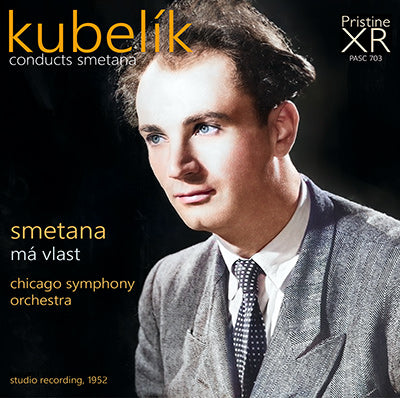
This album is included in the following sets:
This set contains the following albums:
- Producer's Note
- Full Track Listing
- Cover Art
“Sometime immediately before 23 April 1951, two young men boarded a train in New York City and travelled to Chicago carrying a new and technologically ground-breaking microphone. Recording engineers C. Robert (‘Bob’) Fine, 29, and George Piros, 31, arrived at Orchestra Hall the morning of 23 April and began setting up to record the Chicago Symphony Orchestra under the baton of its new conductor, Rafael Kubelík, not yet 37 years old at the time.
Fine hung the Neumann U-47 microphone from a rope, about 15 feet above and slightly behind Kubelík’s head as the conductor stood on his podium. The microphone was connected to a high-fidelity dedicated line provided by the local Bell Telephone company, which terminated at Universal Recording Studio, owned by audio pioneer Bill Putnam. The signal was recorded on Putnam’s Ampex model 300 tape machine, on 3M’s Scotch 111 type magnetic tape, at 15 inches per second. Mercury’s Recording Director, David Hall (34 years old), watched the music scores and, working with Kubelík, made sure that satisfactory ‘takes’ of each piece were committed to tape.
The first reel recorded that day was a test of the equipment and connection while the orchestra performed a practice run-through of Ernest Bloch’s Concerto Grosso. The master-takes of the piece were subsequently recorded that day. Based on the audio quality of the master tapes, the phone patch was improved the next day. The result is the lifelike, in-the-room sound of Mussorgsky/Ravel’s Pictures At an Exhibition and Bartók’s Music for Strings, Percussion and Celesta.
The Mussorgsky and Bartók were both released in 1951 as Mercury MG 50000 and MG 50001, respectively, under the direction of the label’s young director of classical music Wilma Cozart (24 years old). The Pictures LP received especially positive press, including the description by The New York Times music critic Howard Taubman as ‘the living presence’ of the orchestra. Mercury subsequently adopted Taubman’s description as their classical label name. Fine’s single-microphone recording technique became standard operating procedure for Mercury’s Living Presence recordings throughout the mono LP era…
When the Mercury team returned to Chicago in April 1952, Fine drove his new recording truck, a Chevrolet van dubbed the ‘Cinecruiser’ because of its main purpose, recording on-location sound for motion pictures. The van, designed and outfitted at the behest of documentary director Jerome Hill, included new Fairchild tape recorders. During sessions held on 21–22 April that year, the orchestra recorded Tchaikovsky’s ‘Pathétique’ Symphony and Brahms’s First. Unfortunately, only second-generation copy tapes survive for these recordings, with non-optimal sound quality.
The Mercury team, and the recording truck, made another trip to Chicago in 1952, this time in December, a bold late-autumn adventure in those pre-Interstate Highways days. The 4–6 December sessions focused on a Kubelík favourite, Smetana’s Má vlast. Mozart’s Symphony No. 34 was also recorded. Fine again used the Neumann U-47 microphone and Fairchild tape recorder for these recordings. Unfortunately again, only second-generation copy tapes survive for Má vlast and there is audible distortion during some loud passages.” – eloquenceclassics.com
When this recording appeared in the United Kingdom, nearly four years after it was recorded, the critics were not happy with the sound they heard: “Unfortunately, the recording is less satisfactory. It tends to shrillness, as American recordings so often seem to do, and it is not as clear as it should be” was the conclusion of The Gramophone. And it’s true that there is some peak distortion too as a result of that second-generation tape transfer. I have done my best to tame the latter, though you will still hear some of it towards the end of the second movement. But otherwise the recording is a prime candidate for XR remastering to round out the beautifully full sound of the Chicago Symphony Orchestra and unlock even greater listening pleasure from this classic 1952 recording.
Andrew Rose
KUBELÍK Smetana: Má vlast
1. Vyšehrad (The High Castle) (14:48)
2. Vltava (Die Moldau) (11:58)
3. Šárka (9:30)
4. Z ceských luhu a háju (From Bohemian Fields and Groves) (12:48)
5. Tábor (13:31)
6. Blaník (13:56)
Recorded 4-6 December, 1952, Orchestra Hall, Chicago
Chicago Symphony Orchestra
conducted by Rafael Kubelík
XR Remastered by Andrew Rose
Cover artwork based on a photograph of Rafael Kubelík
Total duration: 76:31

